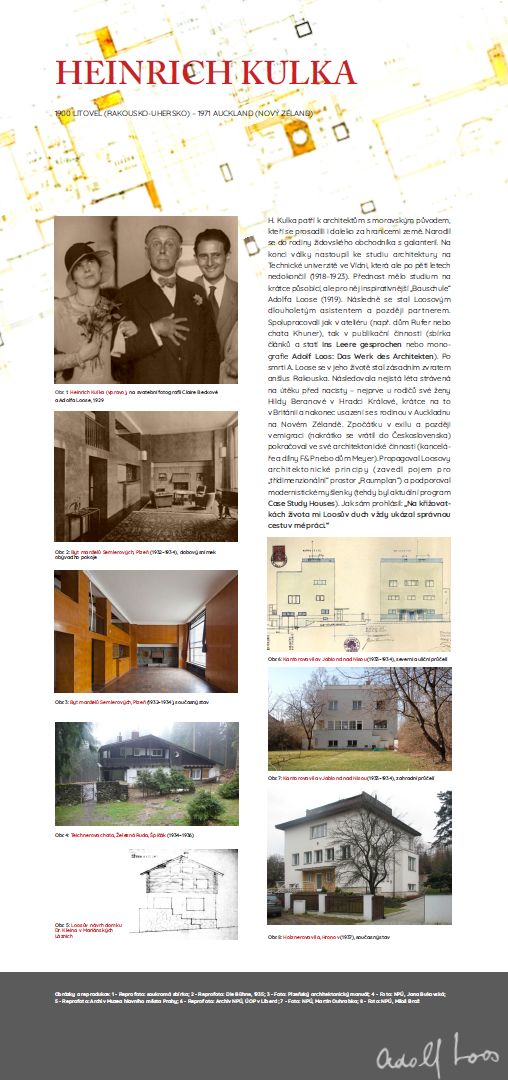Následovníci Adolfa Loose / Adolf Loos Followers
Virtuální prohlídka výstavy / virtual tour of the exhibition
Titul | Adolf Loos | Felix Augenfeld | Friedrich Ehrmann | Paul Engelmann | Jacques Groag | Alfons Hetmanek | Heinrich Kulka | Karel Lhota | Margarete Schütte-Lihotzky | Walter Sobotka | Kurt Unger | Jan Víšek | Rudolf Wels | Ernst Wiesner
Heinrich Kulka
1900 LITOVEL (RAKOUSKO-UHERSKO) – 1971 AUCKLAND (NOVÝ ZÉLAND)
|
H. Kulka patří k architektům s moravským původem, kteří se prosadili i daleko za hranicemi země. Narodil se do rodiny židovského obchodníka s galanterií. Na konci války nastoupil ke studiu architektury na Technické univerzitě ve Vídni, která ale po pěti letech nedokončil (1918–1923). Přednost mělo studium na krátce působící, ale pro něj inspirativnější „Bauschule“ Adolfa Loose (1919). Následně se stal Loosovým dlouholetým asistentem a později partnerem. Spolupracovali jak v ateliéru (např. dům Rufer nebo chata Khuner), tak v publikační činnosti (sbírka článků a statí Ins Leere gesprochen nebo monografie Adolf Loos: Das Werk des Architekten). Po smrti A. Loose se v jeho životě stal zásadním zvratem anšlus Rakouska. Následovala nejistá léta strávená na útěku před nacisty – nejprve u rodičů své ženy Hildy Beranové v Hradci Králové, krátce na to v Británii a nakonec usazení se s rodinou v Auckladnu na Novém Zélandě. Zpočátku v exilu a později v emigraci (nakrátko se vrátil do Československa) pokračoval ve své architektonické činnosti (kanceláře a dílny F&P nebo dům Meyer). Propagoval Loosovy architektonické principy (zavedl pojem pro „třídimenzionální“ prostor „Raumplan“) a podporoval modernistické myšlenky (tehdy byl aktuální program Case Study Houses). Jak sám prohlásil: „Na křižovatkách života mi Loosův duch vždy ukázal správnou cestu v mé práci.“ |
H. Kulka is one of the architects of Moravian origin who established themselves far beyond the borders of their country. He was born into a family of a Jewish haberdashery retailer. At the end of the war, he began studying architecture at the Technical University in Vienna, which he did not complete after five years (1918–1923). Priority was given to studying the briefly active but more inspiring "Bauschule" of Adolf Loos (1919). Subsequently, he became Loos's longtime assistant and later work partner. They collaborated both in the studio (e.g. the Rufer House or the Khuner hut) and in publishing (a collection of articles “Spoken into the Void” (Ins Leere gesprochen) or the monograph Adolf Loos: The Work of the Architect (Das Werk des Architekten). After the death of A. Loos, the anschluss of Austria became a major turning point in his life. This was followed by uncertain years spent on the run from the Nazis – first with the parents of his wife Hilda Beranová in Hradec Králové, shortly afterwards in Britain, and finally settling with his family in Auckland, New Zealand. Initially in exile and later in emigration (he returned to Czechoslovakia briefly), he continued his architectural activities (F&P offices and workshops and the Meyer House). He promoted Loos's architectural principles (he introduced the term "Raumplan" for the "three-dimensional" space) and supported modernist ideas (the Case Study Houses programme was current at that time). As he put it: "At the crossroads of life, Loos’ spirit has always shown me the right path in my work." |
